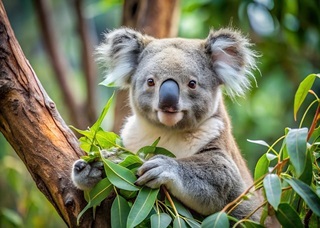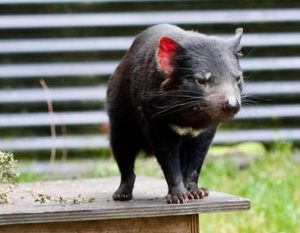
Marsupials are a remarkable group of mammals that have long captured our imagination. Their unique characteristics, fascinating behaviors, and diverse ecological roles make them a subject of great interest for researchers, wildlife enthusiasts, and conservationists alike. Unlike most mammals, which give birth to relatively developed young, marsupials are known for their distinctive reproductive strategy: they give birth to relatively undeveloped young that continue to grow and develop in a pouch. This extraordinary adaptation is famously exemplified in kangaroos and the Koala(Phascolarctos cinereus), but the marsupial family encompasses a wide variety of species, including wombats, possums, the Tasmanian Devil(Sarcophilus harrisii), and many more.
The Diversity Of Marsupials
Marsupials are more associated with Australia, but they can also be found in New Guinea, and the Americas. Marsupials show an astonishing variety in size, shape, and habitat preferences. The largest marsupial is the Red Kangaroo(Osphranter rufus), which can stand over 1.8 meters(6 feet) tall, while the smallestarebthe tiny, mouse-sized planigales. Each species possesses unique adaptations that enable them to thrive in their respective environments.
Kangaroos are perhaps the most iconic representatives of marsupials. They are known for their powerful hind legs, which allow them to cover vast distances in search of food and water. Kangaroos are herbivores, primarily grazing on grasses and leaves, and they play a crucial role in their ecosystem by helping to maintain the balance of plant life. Their unique locomotion also aids in the dispersal of seeds, contributing to the health of their habitat.
Koalas, on the other hand, provide a stark contrast to kangaroos. These tree-dwelling marsupials are known for their specialized diet, which consists almost exclusively of eucalyptus leaves. Koalas have a slow metabolism and spend most of their day sleeping—up to 20 hours—to conserve energy. Their unique adaptations for climbing and grasping branches, such as strong limbs and sharp claws, allow them to navigate their arboreal habitat effectively. However, Koalas face significant threats from habitat destruction making conservation efforts critical for their survival.
Possums are another intriguing group within the marsupial family. These nocturnal creatures are known for their adaptability, as they can thrive in various habitats, from forests to urban areas. The common brushtail possum has become a familiar sight in many Australian cities, often scavenging for food in backyards and parks. Possums play an essential role in their ecosystems by pollinating flowers and dispersing seeds, contributing to plant diversity.
Ecological Roles Of Marsupials
One of the most intriguing aspects of marsupials is their varied ecological roles. They occupy different niches within their environments, and their interactions with other species help maintain the balance of ecosystems. For instance, some marsupials are crucial for seed dispersal. By consuming fruits and traveling long distances, they help spread seeds throughout their habitat, promoting plant diversity and growth.

However, the ecological roles of marsupials extend beyond their immediate environments. They are also part of complex food webs, serving as prey for larger predators. For example, The Tasmanian Devil(Sarcophilus harrisii), which is a carnivorous marsupial, plays a crucial role in its ecosystem by scavenging and consuming carrion. This behavior helps to keep the environment clean and prevents the spread of disease. Unfortunately, Tasmanian Devils are facing significant threats from a transmissible cancer known as Devil Facial Tumor Disease, which has drastically reduced their population in the wild.
Conservation Challenges
As we face increasing environmental challenges, recognizing the ecological significance of marsupials is essential for inspiring action to protect their habitats and ensure their survival for future generations. Habitat loss due to urbanization and agriculture poses the most significant threat to marsupial populations. Many species are highly specialized and rely on specific habitats, making them particularly vulnerable to changes in their environment.
For instance, the Greater Bilby((Macrotis lagotis), once widespread across Australia, has seen its population decline dramatically due to habitat destruction and competition with introduced species such as foxes and feral cats. Conservationists are working diligently to restore Greater Bilby populations through habitat restoration and breeding programs, highlighting the importance of targeted conservation efforts.
In addition to habitat loss many marsupials face threats from invasive species. Introduced predators, such as cats and foxes, have a devastating impact on native wildlife, including marsupials. Conservation programs focused on controlling invasive species, protecting critical habitats, and enhancing public awareness are crucial for safeguarding these unique creatures.
Conservation Efforts
To combat these challenges, various conservation organizations and government agencies are working tirelessly to protect marsupials and their habitats. These efforts include habitat restoration, breeding programs, and public education initiatives. Wildlife corridors are being established to connect fragmented habitats, allowing marsupials to move freely and maintain genetic diversity.
In Australia, the Australian Wildlife Conservancy (AWC) is leading the charge in protecting endangered marsupials through innovative conservation strategies. The AWC manages numerous wildlife sanctuaries, focusing on creating safe havens for threatened species. Their efforts include feral animal control, habitat restoration, and research to better understand the needs of marsupials in the wild.
Community involvement is also a crucial component of conservation efforts. Engaging local communities in conservation initiatives fosters a sense of stewardship and encourages individuals to take action in preserving the natural environment. Educational programs in schools raise awareness about the importance of protecting marsupials and their habitats, nurturing the next generation of conservationists.
For those interested in learning more about marsupials and their role in the ecosystem, visiting a local wildlife sanctuary or participating in conservation programs can be a rewarding experience. Many sanctuaries offer opportunities to observe marsupials in their natural habitats, providing a chance to appreciate their unique adaptations and behaviors firsthand. Additionally, volunteering with conservation organizations can allow individuals to contribute to meaningful projects aimed at protecting these incredible creatures.
The Importance Of Research
Scientific research plays a pivotal role in understanding marsupial biology, behavior, and ecology. Ongoing studies on marsupials help inform conservation strategies and provide insights into their adaptations and interactions within ecosystems. Researchers are utilizing advanced technologies, such as GPS tracking and genetic analysis, to gather valuable data on marsupial populations and their movements.
For example, research on the genetic diversity of marsupials helps identify populations at risk of inbreeding and informs breeding programs aimed at increasing genetic health. Understanding the social structures and behaviors of marsupials also aids in developing effective conservation strategies that take into account their ecological needs.
Moreover, research can shed light on the impact of climate change on marsupial populations. By monitoring changes in habitat use, reproductive success, and survival rates, scientists can better predict how these animals will respond to a changing environment. This knowledge is crucial for developing adaptive management strategies to mitigate the effects of climate change on marsupials.
Celebrating Marsupials
Let us celebrate these incredible creatures and advocate for their future! Marsupials are not only ecologically significant but also culturally iconic. They hold a special place in the hearts of many Australians and are often featured in art, literature, and folklore. Their unique characteristics and behaviors inspire awe and curiosity, reminding us of the incredible diversity of life on Earth.
As we continue to explore the fascinating world of marsupials, it is important to share our knowledge and passion for these animals with others. By fostering awareness and understanding, we can inspire collective action to protect marsupials and their habitats. Whether through community engagement, educational outreach, or support for conservation initiatives, every effort counts in the fight to ensure a future for these remarkable mammals.
In conclusion, marsupials are a unique and diverse group of mammals that play vital roles in their ecosystems. Their fascinating adaptations, ecological significance, and the challenges they face highlight the need for ongoing conservation efforts. By understanding and appreciating these incredible creatures, we can contribute to their preservation and advocate for a more sustainable future for all wildlife. Together, let us celebrate marsupials and work towards protecting their habitats for generations to come.
